|
Bumblebee
checklists
Patterns of description
Sample of names
WWW checklist history
WWW checklist development
.
Aims
for this site. The aim for these web pages is
to give an overview of all of the world's bumblebee
species. The list of species
has to be one person's interpretation, but where possible,
alternative interpretations are presented in the comments
on each species. Updates are added frequently.
.
Bumblebee
checklists
Bumblebees
are relatively well known. Bumblebees have long
been popular with field biologists. As with butterflies
and birds, part of the attraction lies in their bright
colours, large body size, activity during daylight hours,
and abundance in the north-temperate regions where most
collectors and authors have lived. As a result, large
collections of bumblebee specimens have been assembled,
not only from countries like Britain,
but even from the more remote parts of their range,
such as north-east Asia. The rate of discovery of new
species is now low, as shown by the histogram below
(Williams, 1998
[pdf]: new descriptions in grey, cumulative in white).
Therefore bumblebees are a particularly well described
group of organisms with well recorded distributions.
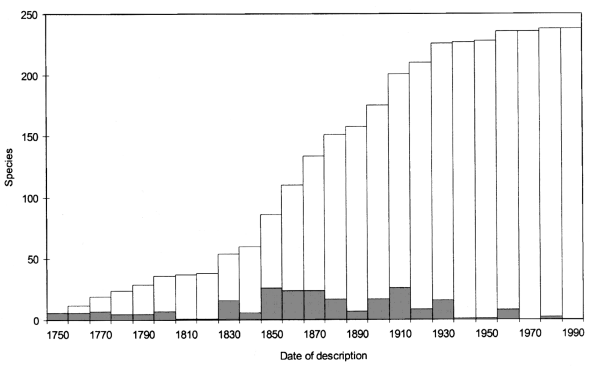
Where
are bumblebees found? The map below shows the
distribution of bumblebee diversity as counts of species
richness around the world. The number of indigenous
species of bumblebees (excluding introductions) is recorded
within each large equal-area (611,000 km²) grid
cell. Equal-area grid cells are important for reducing
bias from species-area effects when comparing regional
richness (otherwise richness tends to be affected strongly
by the size of an area). An equal-area colour
scale is used to emphasise the differences among
regions. Red shows the richest regions, with a white
spot showing the primary global hotspot in Sichuan/Gansu.
In the Old World, bumblebees are particularly species
rich in the southern Tertiary mountains that run from
the Qinghai-Tibetan Plateau and Himalaya westwards to
the Alps and Pyrenees, with another area of high richness
in the north-temperate forest-steppe zone running eastwards
from the Baltic to Inner Mongolia. In the New World,
bumblebees are particularly species-rich in the western
mountains, from the Rockies southwards to the Andes.
Note that many erroneous records and introductions
have been excluded. For comparison, see the richness
maps for honey bees and stingless bees.
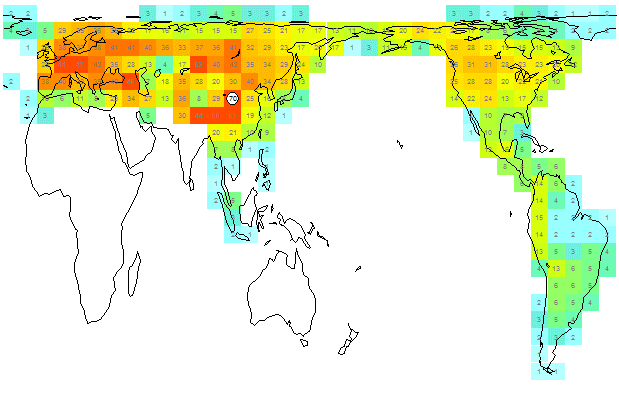
These
grid cells can also be classified by differences in
their faunal composition to recognise different biogeographic
regions specifically for bumblebees (rather than
using the traditional
biogeographic regions based largely on birds):
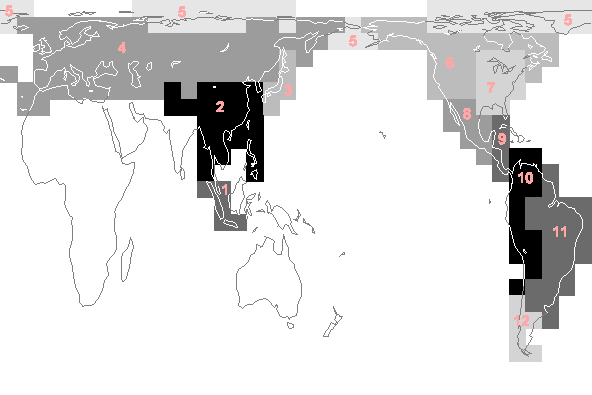
Bumblebees
prefer cool, open, flower-rich habitats, often with
one long but predictable adverse season (usually cold
winters). These conditions characterise subalpine meadows
and north temperate grasslands (see the map above).
The photo below shows high grasslands (3500 m) grazed
by nomadic yak herds in the global hotspot for bumblebees
at the eastern (wetter) end of the Qinghai-Tibetan Plateau
in Sichuan:
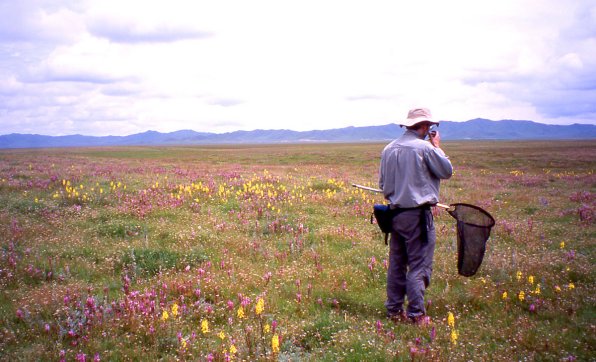
Photo
by S Cameron.
Why
is there no recent revision of all bumblebees?
A problem for biologists trying to identify bumblebee
species, all the more apparent because of the large
amount of material available, is that while bumblebees
have been described as morphologically relatively 'monotonous'
or 'homogeneous' compared to other bees (Michener, 1990,
2000, 2007), they are often extraordinarily variable
within species in the colour patterns
of their pubescence (hair). This is shown for one exemplary
species complex in the map below. As well as differing
within species in colour pattern in different parts
of the world, there is also a confusing tendency for
species to resemble
one another between species in their colour patterns
locally (Plowright & Owen, 1980;
Williams, 2007 [pdf]).
Faced with this variation, generations of taxonomists
since the starting point of Linnaean nomenclature (in
1758) have described
differing individuals under a plethora of more than
2800 names (unpublished catalogue: see Williams, 1998
[pdf]). Most of these names are for taxa below the
rank of species, and ca 260 taxa are interpreted
here as separate species.
Arguably, this nomenclatural burden of more than 11
names per species (median 5, maximum 186) has slowed
progress towards a complete revision of the group. The
situation is made more difficult because most of the
type specimens for all of these names are in institutions
in Europe and North America, whereas the least well
known bumblebees (requiring comparison with more types)
are in Asia and South America.
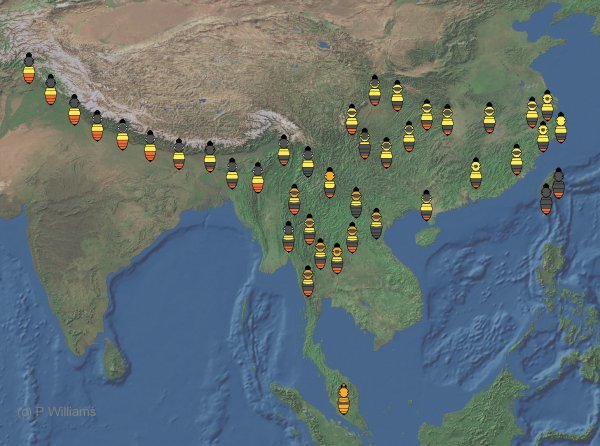
Which
summaries are available? There have been few
attempts to present complete revisions, catalogues or
checklists of all bumblebee species from which to see
summaries of past views. Latreille (1809)
included 13 species in his genus Bombus. Most
early lists included just those species seen by the
authors, usually from particular collections, and often
from just one region. For example, Smith (1854)
catalogued 87 bumblebee species (79 Bombus +
8 Apathus [= Psithyrus]) in the collection
of the British Museum. The only truly synoptic catalogue
of bumblebees was published by Dalla Torre (1896),
with 255 (non-fossil) species (228 Bombus + 27
Psithyrus). His catalogue included many varietal
names, synonyms and early references. The reason why
Dalla Torre's species count exceeds the total recognised
here as described before 1899 (159 species) is that
many of his species are now treated as synonyms or subspecies.
Later, Skorikov ([1923])
listed 237 species (plus 70 'Bombi incertae sedis'),
but with few synonyms and without including Psithyrus.
Skorikov's list is also interesting because it arranged
most of the known species within his genera and subgenera,
which form the basis of the subgeneric
system, which has recently been revised.
Why
do we need a new overview? Nearly half of the
c. 2800 bumblebee names have been published since the
last world-wide checklist in 1923. Consequently, there
has been a need for a new overview. The checklist
on these web pages begins to address this need. This
checklist cannot be expected to solve all biological
and nomenclatural
problems so it is bound to require revision. However,
it is hoped that it provides an improved framework to
support more detailed regional studies, and that by
identifying some of the major problems it will stimulate
further research.
.
Patterns
of description
When
seeking to interpret patterns in diversity, ecology
and biogeography, any regional or taxon-based bias in
patterns of taxonomic description needs to be understood.
The
geographical range size of a species has had an effect
on when it was first described and (directly or indirectly)
on how many names it has attracted. Below is a scatterplot
showing the relationship for the presently accepted
bumblebee species between the dates of their first description
(x axis), their global range sizes (y
axis: number of occupied 611,000 km² grid cells world-wide,
see the map above), and their numbers of synonyms and
subspecific names (z axis: infrasubspecific names
are excluded). The British fauna is distinguished as
filled triangles, the nearly circumpolar fauna (B.
hyperboreus, B. balteatus, B. polaris and B.
lapponicus) as squares, and some British and widespread
European species are labelled individually (B. hypnorum
has recently joined the British fauna, Goulson &
Williams, 2001
[pdf]).
|